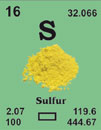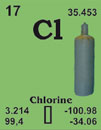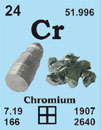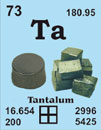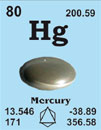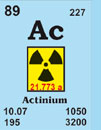Holmium 67Ho164.930
Holmium was discoverd in 1878 by P.T. Cleve at Uppsala, Sweden, and independently by M. Delafontaine and J.L. Soret at Geneva, Switzerland.
[Greek: Holmia = Sweden]
French: holmium
German: holmium
Italian: olmio
Spanish: holmio
Description: Holmium is a silvery metal of the so-called rare earth group (more correctly termed the lanthanides). It is slowly attacked by oxygen and water, and dissolves in acids. Holmium is used as a flux concentrator for high magnetic fields.
Holmium single crystal properties
| State: |
Single crystal |
|---|
| Crystal structure: |
hexagonal |
|---|
| Production method: |
Floating zone |
|---|
| Standard size: |
diameter 7-8mm
thickness 1mm |
|---|
| Orientation: |
(0001) |
|---|
| Orientation accuracy: |
<2°, <1°, <0.4° or <0.1° |
|---|
| Polishing: |
as cut, one or two sides polished |
|---|
| Roughness of surface: |
<0.03 µm |
|---|
| Purity: |
99.99% |
|---|
Further Materials properties
| Crystal structure: |
(cell dimensions/pm), space group
a-Ho h.c.p. (a=357.73, c=561.58), P63/mmc
b-Ho b.c.c. (a=396), Im3m
T(a -> a)= just below melting point
High pressure form: (a=334, c=2410), R3m |
|---|
| X-ray diffractions mass absorption coefficients: |
CuKa 128 (µ/r) / cm2g-1
MoKa 73.9 (µ/r) / cm2g-1 |
|---|
| Neutron scattering length: |
0.808 b/10-12 cm |
|---|
| Thermal neutron capture cross-section: |
65 sa / barns |
|---|
| Density: |
8.8 kg/m-3 [293 K]; 2390 [liquid at m.p.] |
|---|
| Melting point: |
1473.85 °C / 1747 °K |
|---|
| Boiling point: |
2694.85 °C / 2968 °K |
|---|
| Molar volume: |
18.75 cm3 |
|---|
| Thermal conductivity: |
16.2 [300 K] Wm-1K-1 |
|---|
| Coefficient of linear thermal expansion: |
9.5 x 10-6 K-1 |
|---|
| Electrical resistivity: |
87.0 x 10-8 [293 K] Wm |
|---|
| Mass magnetic susceptibility: |
+5.49 x 10-6(s) kg-1m3 |
|---|
| Young's modulus: |
64.8 GPa |
|---|
| Rigidity modulus: |
26.3 GPa |
|---|
| Bulk modulus: |
40.2 GPa |
|---|
| Poisson's ratio: |
0.231 GPa |
|---|
| Radi: |
Ho3+ 89; atomic 177; covalent 158 |
|---|
| Electronegativity: |
1.23 (Pauling); 1.10 (Allred); £3.3 eV (absolute) |
|---|
| Effective nuclear charge: |
2.85 (Slater); 8.44 (Clementi); 11.60 (Froese-Fischer) |
|---|
| Number of Isotopes (incl. nuclear isomers): |
39 |
|---|
| Isotope mass range: |
148 -> 170 |
|---|
Biological data
| Biological role: |
none, but acts to stimulate metabolism |
|---|
| Toxicity |
|
|---|
| Toxic intake: |
n.a. |
|---|
| Lethal intake: |
LD50 (chloride, oral, mouse)=7200 mg kg-1 |
|---|
| Hazards: |
Holmium is mildly toxic by ingestion |
|---|
| Level in humans |
|
|---|
| Organs: |
n.a., but low |
|---|
| Daily dietary intake: |
n.a. |
|---|
Total mass of element in average
[70 kg] person: |
n.a. |
|---|
Geological data
| Minerals: | Many minerals are known, and aluminium is present in many other minerals |
|---|
| Mineral | Formula | Density | Hardness | Crystal apperance |
|---|
| Bastnäsite |
(Ce, La etc.) Co3F |
4.9 |
4 - 4.5 |
hex., vit./greasy yellow |
| Monazite |
(Ce, La, Nd, Th etc.) PO4 |
5.20 |
5 - 5.5 |
mon., waxy/vit., yellow-brown |
| Chief ore: |
monazite, bastnäsite |
|---|
| World production: |
c. 10 tonnes/year |
|---|
| Main mining areas: |
USA, Brazil, India, Sri Lanka, Australia, China |
|---|
| Reserves: |
4 x 105 tonnes |
|---|
| Specimen: |
available as ingots or granules. Safe. |
|---|
| Abundances |
|
|---|
| Sun: |
n.a. |
|---|
| Earth's crust: |
1.4 ppm |
|---|
| Seawater: |
|
|---|
| Atlantic surface: |
2.4 x 10-7 ppm |
|---|
| Atlantic deep: |
2.9 x 10-7 ppm |
|---|
| Pacific surface: |
1.6 x 10-7 ppm |
|---|
| Pacific deep: |
5.8 x 10-7 ppm |
|---|
| Residence time: |
n.a. |
|---|
| Classification: |
recycled |
|---|
| Oxidation state: |
III |
|---|
Other sizes and specifications on request

 English
English
 Deutsch
Deutsch
















